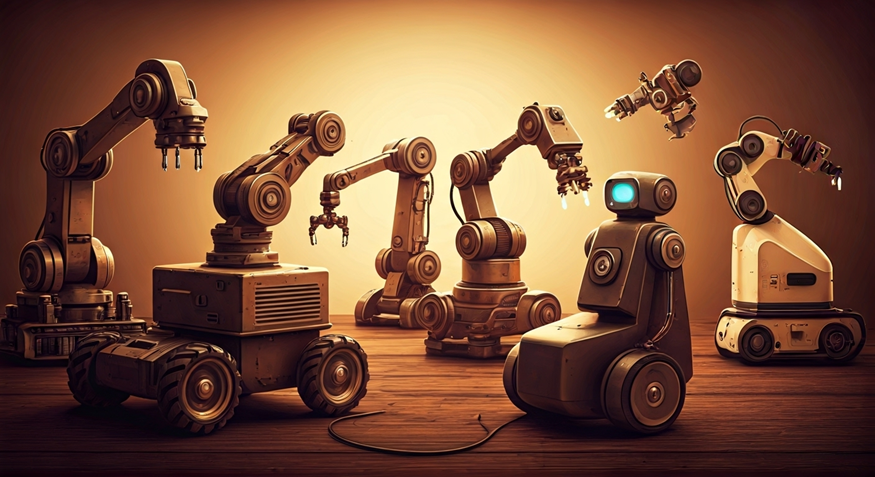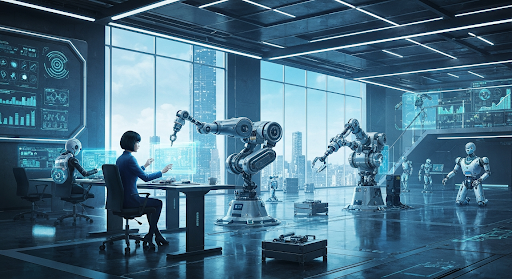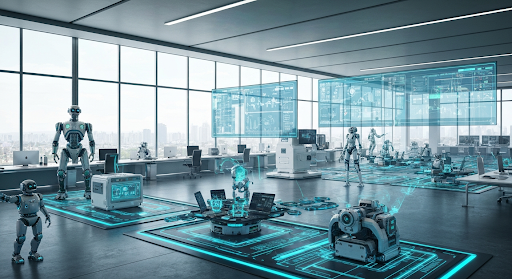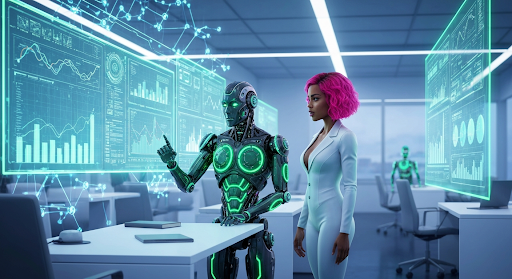A Simple Guide to Robots Automation Explained
Key Highlights
- Robot automation combines robotic systems and advanced automation technology to perform specific tasks with minimal human intervention.
- Software robots, robotic process automation (RPA), and industrial robots streamline business processes and repetitive tasks efficiently.
- Collaborative robots (cobots) work alongside humans, enhancing safety and employee satisfaction.
- Intelligent automation incorporates artificial intelligence and machine learning, boosting smarter automation and adapting to complex tasks.
- Industries like manufacturing, healthcare, and financial services benefit from robotic automation for faster, safer, and more reliable processes.
- Robot automation transforms customer service, internal processes, and business process automation while driving digital transformation efforts across sectors.
Introduction
Robot automation is changing how we work in many industries. It brings automation technology into everyday work. By using robotic process automation and intelligent automation, companies can handle complex tasks more easily. This lets them finish jobs faster and get better results. Automation helps businesses do repetitive tasks with less effort, so they can focus on new ideas and stay ahead in the market. Some use physical robots for jobs like making things in factories, while others use software robots for business process automation. No matter which way they choose, robot automation is making the world smarter and helping companies move forward with digital transformation.
Understanding Robot Automation

Robot automation brings technology to life. It uses robotics, intelligent automation, and software solutions to change how processes work. By using automation technology, businesses can get work done much faster and with better accuracy, especially for specific and strategic activities.
Intelligent automation makes systems better. It does this by bringing together machine learning and artificial intelligence to make automation smarter. Robots, which can be real machines or digital tools, do many tasks in places like manufacturing, customer service, and normal business processes. This strong mix of robotics and automation helps people work with more accuracy, more efficiency, and brings new ways to get things done.
Defining Robot Automation in Simple Terms
Robot automation, also called robotic process automation (RPA), uses software robots to handle specific tasks. These aren't physical robots. Instead, software bots take on repetitive digital tasks such as entering data or managing transactions for a business process. They do this work non-stop, and this helps to keep all the results accurate and the same each time.
Physical robots are different. They are mainly used in industrial places. These robots be great for things like assembling items or welding, and they do these things again and again very well. Physical robots are the reason why automated production lines work smoothly in factories and other places.
Robotic automation is known for its flexibility. It can make things easier for both internal processes and customer service tasks. Whether you use it in an office or on a factory floor, robot automation takes away the need for people to do the same work over and over. This lets you get the most out of business process automation. You can even program these machines to handle complex tasks, which is why they are so important today in jobs that need new ideas and more advanced ways to work.
How Robot Automation Differs from Traditional Automation
Robot automation and traditional automation both help to make work easier and faster. But, they do this in different ways and each has its own focus. Traditional automation often uses standard process automation systems. These can be things like conveyor belts or other machines that need a lot of human intervention. People still have to do a lot with these systems.
On the other hand, robot automation uses AI-driven software and physical robots. These robots can work on their own and do many tasks without human help.
Unlike the older systems, robotic automation works well in changing setups. It uses intelligent process automation, which means it can make choices in real time and does not need someone to watch over it all the time. For example, an automated production line with robot automation can change its setup easily. The traditional setup has a hard time with such change, as it is fixed.
Also, traditional automation always repeats the same actions. Robot automation uses machine learning. It can learn and change the way it works as needed. This kind of process automation cuts down human error, helps employee satisfaction, and makes a smarter automation system. Because of this, robotic systems are more adaptable and ready for the future.
Core Components of Robot Automation
Robot automation is all about using robotic systems and having hardware like sensors and actuators work with smart computer software. These parts come together, helping with process automation in many industries.
The hardware does all the things needed in the physical world. It helps robots do complex tasks. At the same time, computer software uses AI and machine learning. This lets robots get better at problem-solving. Bringing hardware and software together makes a strong base for smarter automation. It helps companies in things like manufacturing, healthcare, and financial services. Now, let’s look more closely at these main components.
Hardware Elements: Sensors, Actuators, and Controllers
The hardware in robotic systems has some main parts. The most important are sensors, actuators, and controllers. Sensors are like the eyes and ears for robots. They help it be aware of the physical world by noticing things such as light, sound, and changes in temperature. Because of sensors, robots can move around tough places in a smooth way.
Actuators are like the robot’s muscles. They let a robot lift stuff, weld metals, or move fragile tools with exact control.
Controllers act like the brain of a robot. The controller sets the order of things that need to be done and manages how every task works. By bringing together information from sensors and sending it to actuators, the controller helps the robot do the right things, even when the world around it changes. When these parts work together, robots can handle process automation and move in the physical world better than ever.
Software: Programming and Artificial Intelligence
Software is at the heart of robotic automation and helps robots make decisions. The mix of computer science and artificial intelligence lets programming guide robots so they do their work with high efficiency and can adjust when things change. With machine learning, robots can learn from what is around them. They use this to make their own process automation better as time goes on.
Artificial intelligence helps create intelligent automation because it lets robots solve hard problems by themselves. For example, in customer service, smart software bots use natural language processing to answer questions that people have.
These new changes in technology are taking robotic process automation to the next level. Software solutions work well with the hardware parts, so robotic systems can be precise, give smarter automation, and be very flexible. This makes robotic automation a must-have in many industries and helps businesses get more out of doing things automatically.
Types of Robot Automation

automation covers a few main types. There are programmable machines made to do specific tasks, and there are bigger systems used in both factories and service industries. Each type of robot automation is made to fit the needs of each industry. They help make processes better.
Industrial automation is about using physical robots in factories to handle work. Service robots are used in places like hospitals and stores. They help customers or staff. Collaborative robots bring something new to the table by working safely with human workers nearby. In the next part, we will talk more about these types and explain how their roles and skills are not the same.
Industrial Robots vs. Service Robots
| Aspect | Industrial Robots | Service Robots |
|---|---|---|
| Application | Used in manufacturing and industrial automation | Operate in healthcare, retail, and customer service industries |
| Design | Built for speed, power, and repetitive tasks | Designed for interaction and affordability |
| Examples | Automated production lines, robotic welders | Robot vacuum cleaners, interactive greeters |
| Environment | Controlled factory or warehouse | Dynamic, human-facing environments |
Industrial robots excel in tasks requiring precision and repetition, such as welding or assembly. They dominate automated production lines with unmatched efficiency, boosting output.
Service robots operate in settings like hospitals or hotels, assisting with guidance, cleaning, and customer service. Their focus on interaction and affordability makes them ideal for non-industrial processes, adapting to human needs dynamically.
Collaborative Robots (Cobots) and Their Roles
Collaborative robots, also called cobots, are now a big part of automation technology. They work with people to help them, not to take their jobs. These robotic systems be made to work next to human workers in many settings. Cobots help lower the chance of human error. They handle repetitive tasks that can slow down people. When you add machine learning and computer vision to cobots, they get even better at what they do.
Cobots also make internal processes work better. Their flexibility makes them helpful in so many areas. You will find them in manufacturing, customer service, and more. This close way of working helps humans and robotic systems achieve more together. It allows for a strong and smooth partnership between people and machines.
Key Benefits of Robot Automation
Robot automation gives many good benefits. It helps employees feel better at work and leads to smarter automation. By taking care of repetitive tasks, it lets people work faster and brings real improvements in how much work gets done.
With automation technology, companies can also make their internal processes stronger and safer. It keeps work steady and safe for everyone. This technology can change and fit different types of business. It makes business process automation smooth and brings new ways to grow for a long time. In the next sections, we will talk about how process automation leads to more productivity and a safer workplace.
Increased Efficiency and Productivity
Efficiency is at the center of robotic automation. Robots handle repetitive tasks, and this helps many industries like manufacturing and warehousing work faster. When there are fully automated production lines, there is less downtime. This lowers the chance of errors and helps to get more done.
Robotic systems also be used to do complex tasks with strong, programmed precision. They help companies grow without trouble. For example, these systems help manage inventory better and handle materials fast, making logistics smoother.
All this intelligent automation leads to higher production, and it gives people more time to do strategic activities. This makes workflows smarter and helps companies build better business models.
Enhanced Safety and Consistency
Safety and consistency are key parts of robot automation. Robots help cut down on human error by doing internal processes with more care and accuracy. This makes sure the results are steady every time. For example, sensors find dangers and help stop accidents, and controllers run programs the right way every time.
Repetitive tasks can sometimes be risky, but automation technology helps a lot with these problems at work. In places like manufacturing, physical robots help by picking up heavy things or working in places that are too dangerous for people. This keeps employees safer.
When you have consistency along with better safety, it helps people trust things like quality checks. Smarter automation helps give the same good results all the time.
Real-World Applications of Robot Automation
Robot automation is changing many industries with the use of automation technology. From the factory floor to customer service areas, companies use robots to help with their work and make operations run smoother. The use of robot automation helps make internal processes better and more modern.
Physical robots are good at jobs that need the same action again and again. On the other hand, software solutions help with many repetitive digital tasks around the world. You will see below how robot automation is used in areas like manufacturing, healthcare, and retail. This will show how automation and robots help people move forward and make things work better.
Manufacturing and Warehousing
Robot automation is changing how things work in manufacturing and warehousing through process automation. Physical robots take on jobs like welding, painting, and moving materials. They do these tasks with great care and make production much faster.
In warehouses, automated systems help to sort and pack goods. This brings down the need for human intervention. Robots help supply chains run smoother, so there are fewer problems. At the same time, they keep things accurate.
These systems make it safer and more efficient as robots do tough and dangerous jobs, such as lifting heavy things. This change helps keep businesses competitive. It also lets them handle the growing needs of people in a smooth way.
Healthcare, Retail, and Beyond
Automation technology is not only used in manufacturing. It is also found in healthcare, retail, and financial services. In healthcare, robots help with surgeries. They also help give out medicine. This leads to good results and high accuracy.
In retail, automated systems help with stock control. They also answer customer questions. This makes the service better for the people. Financial services use software robots. These robots help to handle tasks like looking at data and making transactions.
These uses show how flexible robot automation is. With process automation, businesses can work smarter. It also helps make business process automation and digital transformation easier and better.
Conclusion
To sum up, robot automation is changing the way many industries work. It helps them to be more efficient, get more done, and be safer. When you know about the parts that make up robot automation—like sensors, actuators, and the smart software that runs them—you see how much robots can do in different fields. In places like manufacturing, healthcare, and retail, you will find robot automation being used in many ways, and these uses keep growing. When companies start to use robot automation, they make their work smoother and the workplace safer at the same time. If you want to find out how robot automation can help your business, you can get in touch for a free talk about your choices.
Frequently Asked Questions
What jobs can robots automate today?
Robots now help to automate many repetitive tasks in factories and on assembly lines. They also work in image recognition, customer service, and other business processes like data entry. Software robots make business process automation better by quickly handling digital jobs. They do this work so people have more time for strategic activities.
Are robots replacing humans workers?
Robots work with people instead of taking over every task. They help make jobs easier by handling both digital and physical work, but they still need human intervention and human judgment for some choices. When robots take care of repetitive tasks, people have more time to focus on creative or strategic activities. This change helps employee satisfaction and leads to smarter automation over time.
Can small businesses use robot automation?
Small businesses can use robot automation in simple ways that do not cost much. They can try RPA bots and software robots for this. You will see that these solutions help with business process automation. They work best for repetitive tasks, like setting up appointments and putting in data. This smarter use of automation technology helps a business grow. It also makes the business process flow better and saves time for people.
How safe is it to work alongside robots?
Collaborative robots help keep everyone safe. They lower the chance of human error because they have smart features. One of these is computer vision. They also have programmed controls. These robots are made to work with human judgment. You can see them working side by side with people in the same space. They focus on getting the same good results every time. At the same time, they do not put employee well-being at risk.
What is the future of robot automation in the United States?
The future of robotic automation in the United States is set to bring together AI, process mining, and intelligent process automation. The Harvard Business Review says that digital transformation will help create new ways to use this technology. This will lead to smarter automation in different industries and may change business strategies for many companies.
What are the key benefits of robots in automation?
Robots in automation offer numerous benefits, including enhanced efficiency by performing repetitive tasks, improved accuracy reducing human error, and increased safety by handling hazardous operations. Additionally, they can operate continuously without fatigue, leading to higher productivity and cost savings for businesses in various industries.



